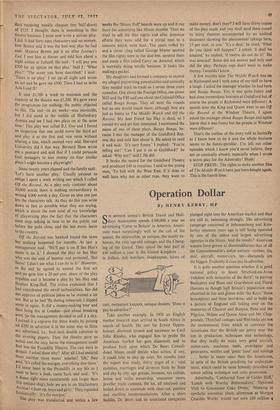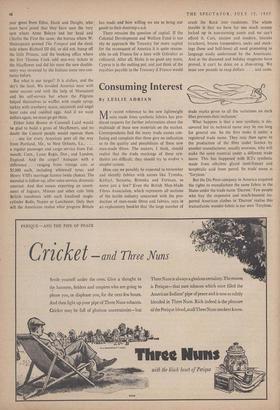Operation Dollar
By HENRY KERBY, MP
alIR ARTHUR MORSE'S British Travel and Holi- days Association spends £500,000 a year on advertising 'Come to Britain' in America. Ameri- cans react surprisingly well to the call of the quaint, the oldeworlde, ye antique, the stately ex- homes, the cosy age-old cottages and the Chang- ing of the Guard. They spend the best part of £40 million a year in the United Kingdom . . . in dollars. Ask hoteliers, shopkeepers, hirers of
cars, restaurant keepers, antique dealers, 'Does it pay to advertise?'
Take another example. In 1938 an English market research man arrived in South Africa in search of health. He met Sir Ernest Oppen- heimer, diamond tycoon and successor to Cecil John Rhodes, who engaged him to probe the American market for gem diamonds and to produce facts upon which De Beers Consoli- dated Mines could decide what action, if any, it could take to step up sales. Six months later the report was ready, thirty pages of it : vital statistics, marriages and divorces State by State and city by city, age groups, incomes, tax ratings, house and radio ownership, consumer views, jeweller trade customs, the lot, all analysed and boiled down to essentials with clear-cut, positive and startling recommendations. After a short huddle, De Beers and its associated companies plunged right into the American market and they are still in, swimming strongly. The advertising campaign conceived in Johannesburg and Kim- berley nineteen years ago is still being operated by one of the oldest and largest advertising agencies in the States. And the results? American women have grown so diamondiferous that of all the Commonwealth's dollar earners—rubber, tin, sisal, aircraft, motor-cars, tea—diamonds are the biggest. Evidently it does pay to advertise.
It is quite another question whether it is good national policy to boost Stratford-on-Avon 'redolent with memories of the Bard'; to portray Beefeaters and Blues and Guardsmen and Floral Dancers as though half Britain's population was absorbed in fun and games with 'the Keys,' those breastplates and these bearskins; and to build up a picture of England still ticking over on the memories of Chaucer and Bunyan, Penn and the Pilgrims, Milton and Queen Anne and Mr. Chip- pendale. Thatched cottages and flint-locks are not the environment from which to convince the Americans that the British are pretty near the top in production techniques and technology, that they really do make very good aircraft, motor-cars, machines tools, switchgear and generators, textiles and 'gents' hose' and suitings . . . better in many cases than the Americans, in spite of the British proclivity for understate- ment, which could be more honestly described as rotten selling technique and sales promotion.
Admittedly, 'Conducted Tour of Calder Hall,' `Lunch with Worthy Boilermakers,' Optional Visit to Grassmoor Coke Ovens,' Morning at synthetic ammonia plant, afternoon at Morgan Crucible Works' would not earn £40 million it year gross from Edna, Hank and Dwight, who must have-proof that they have seen the very spot where Anne Boleyn lost her head and Charles the First the same; the bureau where W. Shakespeare penned The Tempest and the dank hole where Richard III did, or did not, bump off the little Princes; and the booking office where the first Thomas Cook sold one-way tickets in the Mayflower and did his sums the new double- entry way invented by the Italians some two cen- turies before.
But what is our target? It is dollars, and the sky's the limit. We invaded America once with some success and with the help of Massassoit and his self-service bar where the Pilgrims helped themselves to waffles with maple syrup, turkey with cranberry sauce, succotash and angel layer cake and coddled eggs. And if we want dollars again, we must go get them.
Either John Brown or Cammell Laird would be glad to build a gross of Mayflowers, and no doubt the Cunard people would operate them . . . one for every American port all the way from Portland, Me., to New Orleans, La., . . . a regular passenger and cargo service from Fal- mouth, Corn., Lyme Regis, Dor., and London, England. And the cargo? Antiques with a difference . . . ranging from vintage cars at $5,000 each, including whitewall tyres, and Henry VIII's marriage licence (wide choice). The essential is follow-up, after-sales-service, dramatic contrast. And that means exporting an assort- ment of Jaguars, Minxes and other cute little British runabouts with each fossilised single- cylinder Rolls, Napier or Lanchester. Only then will the Americans realise what progress Britain has made and how willing we are to bring our goods to their doorstep c.o.d.
There remains the question of capital. If the Colonial Development and Welfare Fund is too shy 4o approach the Treasury for more capital for the reconquest of America it is quite reason- able to ask Franco for a loan with Gibraltar as collateral. After all, Malta is no good any more, Cyprus is in the melting pot, and just think of the royalties payable to the Treasury if Franco would crush the Rock into roadstone. The whole trouble is that we have far too much money locked up in non-earning assets and we can't afford it. Cars, ancient and modern, biscuits (crackers), braces (suspenders), socks and stock- ings (hose and half-hose) all need promoting in language easily understood by the Americans. And as the diamond and holiday magnates have proved, it can't be done on a shoe-string. We must sow pounds to reap dollars . . . and cents.















































 Previous page
Previous page